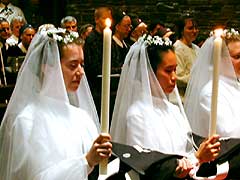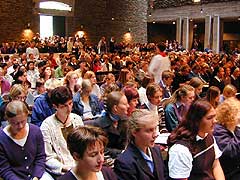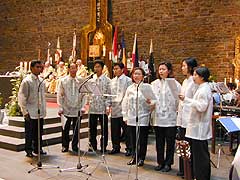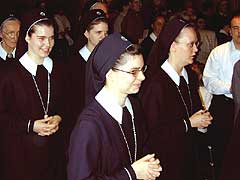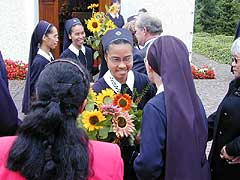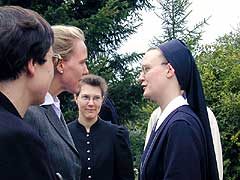The Call to Live Sanctity Today –
With and Because of Limitations and Broken Pieces
"I believe in my vocation" –
Emilie Engel previously and ten young women on September 3, 2000
(mkf) The first biography on Schoenstatt Sister Emilie Engel (1889-1955) was presented in Schoenstatt on the eve of ten young women's reception into the community of the Schoenstatt Sisters of Mary. The author's and some readers' comments revealed a surprising and freeing concept of holiness: The call to live sanctity today with and because of the limitations and broken pieces of life. More than a thousand relatives and friends of the young sisters, youth, and people from the area around Schoenstatt participated in the Reception Day program at Schoenstatt.
"Many people have waited a long time for this book," said Sr. M. Theres Beermann when she, in the name of the Schoenstatt Sisters of Mary, presented the first biography of Sr. Emilie Engel to the public on September 2, 2000. Approximately 160 people came to the Father Kentenich House on Mount Schoenstatt for this presentation. The Vallendar music band "Esperamor" provided the music and set the tone for an encounter marked by anticipation, joy, and surprise. Displays in the entrance hall gave first insights into the book. Sr. Thomasine Treese, postulator for Emilie Engel's process of beatification, highlighted the importance of a book about Sr. Emilie. The author, Sr. Gretelmaria Wolff, then shared how this biography was developed, relating her own surprise at the large amount of material available from and about Sr. Emilie, filling a long row of files. Is Emilie's life worth a biography, and is she a saint? These questions guided the author's personal research and helped her to discover a woman whose life was marked by crises, limitations, broken pieces and difficulties. This woman believed in her vocation; and, led by Father Kentenich's words and guidance, she did not break down under these pressures but developed a joyfully radiant and confident attitude of being God's beloved child, caring for each one entrusted to her.
A surprising and freeing concept of holiness
Gerd Freisberg and his wife had both read the book. Gerd Freisberg, who had even ignored his car magazines while reading about Emilie Engel, found a surprising and freeing concept of holiness revealed in the chapters of this book. "Holiness is not perfection. Holiness is to try again and
again to give oneself into God's hands and will. Holiness does not come with constant bliss and a shining halo. And the path to holiness is not constantly leading uphill to ever greater perfection. Small steps are to be taken, and steps backward are not the end of the world." His wife
nodded. "I got a totally new understanding of holiness and of the Schoenstatt Sisters of Mary," she added. "Until I read the book, I thought that Schoenstatt Sisters, once they made their decision and had reception, would live in perfection. This concept of holiness broke to pieces. That means that for the first time in my life I think I also might have a chance to become holy, although so often I do not want to do what I should."
Emilie Engel's life thus proved to be a potential model for modern people. "Re-reading some paragraphs," Herr Freisberg shared, "I marked them with stickers and thus made the book my ppersonal encyclopedia of sanctity."
Ten young women from Germany, Hungary, India, and the Philippines, who on Sunday morning processed into the Adoration Church dressed in bridal white, answered the call to live everyday sanctity in the Secular Institute of the Schoenstatt Sisters of Mary, believing in their vocation as
Emilie Engel did. "Each person is called by God," said Monsignor Zimmerer in his sermon, "called to be a priest or to join a religious order or a Secular Institute, called to marry, or called to a special task in life. Each vocation has to be lived in the covenant with the Triune God, each day anew."
Led by Father Kentenich - At Home in a Family and in God
Mrs. Freisberg had gotten another surprising insight. Like God needed Mary for his plans to become reality, Father Kentenich needed Emilie. "But Emilie Engel also needed Schoenstatt, and she needed to meet Father Kentenich," added her husband. Gertrud Beilmann, a member of the Women's Federation, highlighted the inner growth of Emilie Engel, led by Father Kentenich who accepted her with her limitations and helped her to find inner freedom and strength. And Father Kentenich needed her, Gertrud Beilmann continued, like he needed Gertraud von Bullion. Gertraud's vocation was to be the first woman to join Schoenstatt and become the founder of the Apostolic Women's federation, while Emilie, who for years worked for Schoenstatt in the Apostolic Women's federation, was called to be responsible for the development of the Sisters as a community of women who make Schoenstatt their profession.
On Sunday morning, when the ten young women received their new, self-chosen name, the veil, the medal with the picture of Jesus and Mary, and the lighted candle, this call and their decision to follow it were expressed. When the novices walked out to change their dresses, six candidates from five countries - Puerto Rico, Dominican Republic, India, Philippines, Czech Republic - sang a song in English and Tagalog as an expression of their support for the novices and their own
joy in their vocation to become Schoenstatt Sisters next year.
Like Emilie, the young sisters are at home in a family, in the Sisters' family and in the Schoenstatt family. Several Filipino Schoenstatt members and friends had come from Frankfurt, Rüsselsheim, Bonn, Lohmar, and other places to express their joy and solidarity. Eight members of the Filipino choir "The Loved Flock" from Bonn had been invited by a Schoenstatt member to sing during this celebration. Their songs about finding a home and all richness in God pointed to the ultimate goal of these young women, the secret of Emilie Engel's life, to find and lead the way home to the Eternal Father, the loving, merciful Father.
"These were the resources that made Emilie Engel able to overcome her tuberculosis and the physical needs of such a sickness," said Birgit Brömmel, a teacher at a nursing school, who had read the book on Emilie Engel in view of a thesis she is to write on a new theoretical concept in medicine. "This theory points to the resources which are to be found especially in social contacts, intellectual insights leading to an awareness and spiritual orientation. I found all that when I read this book – Emilie was at home in the family of Sisters and the Schoenstatt family. Father Kentenich helped her to understand the meaning of her sickness and gave her tasks and a mission so she was not caught in a frustrating 'why me?' She had to think about the 'how' of her new tasks, and she had Schoenstatt, her home in the shrine and in God." Birgit shared that she plans to write her thesis on Sr. Emilie's way of coping with her sickness.
Thank you for your Yes
After the statements, Sr. Gretelmaria summaarized the main aspects of the biography, ending with a personal word to Sr. Emilie: "Thank you for your 'Yes'!" The music band Esperamor sang, while some people went to the entrance hall for juice, snacks, sharing, and to buy books. The youngest
participant, Elaine, drew the winners of the prize competition – how many letters did Emilie write to Father Kentenich before October 1, 1926 (founding day of the Schoenstatt Sisters of Mary), and how many letters did she receive from him? Most of the participants were right about the number of letters written by Emilie, but most of them also underestimated the number of letters written by Father Kentenich. Forty-four participants were right.
Father Barmettler, winner of the prize – a voucher for the second volume with sources to be published soon – announced the correct numbers: 38 letters from Emilie, 27 from Father Kentenich. A Schoenstatt Sister from Argentina and a girl from Belorussia won the biography. Helena will have to study German to be able to read the book, but she already asked for a dictionary!
Thank you for your "yes." This was also expressed by the participants of the reception on Sunday. "Thank you" to the ten novices and to each one who is ready to respond to his or her personal call. The Schoenstatt Girls Youth had a special reason to give thanks. Because of the reception of the ten novices, they had a "reason" to meet again after the International Meeting (August 10-13).
After a variety of projects and alternative programs on Saturday afternoon, they had met in House Sonnenau to watch a video about their meeting and listen to songs by Susanne Leibrecht, written in the atmosphere of this International Meeting. On Sunday afternoon, the festive benediction at 3:30 PM summarized all the gratitude and inspiration from this day – to live sanctity today, with and because of limitations and broken pieces.
English edition: Joan Biemert, New Franken, WI, USA

